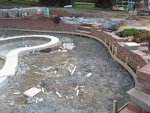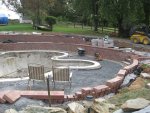OK, I think I got the picture now.
I think the biggest issue is the base that was used. See, the problem is that different areas of the country use different terms for gravels, stone, crusher run, etc. #57 stone is probably too big to use under a concrete deck. The straight crusher run you used here doesnt contain any dirt fines. Up here in New England, what we call processed gravel is a mix of 1/2" stone and seived dirt. It compacts really well but yet drains extremely well. Not sure what they call it in your area, but thats the proper material to use under a deck like this. Normally, you would excavate 12-18 inches of material out and put in processed gravel compacted in 6 inch lifts. This makes a good, hard base for the concrete that will drain really well.
Im not sure why the PB told you not to put in pavers with a sand base near the pool. It's done all the time. I prefer stone dust to sand, but both will work. If you pull up the deck, you will need to pull out about 18 inches or so of that stone, replace it with processed material up to 6.5 inches inches below the top of the coping (you want 4 inches of sand/stone dust base plus the thickness of the paver to bring the top of the paver flush with the coping). Then lay your pavers.


 )
)
